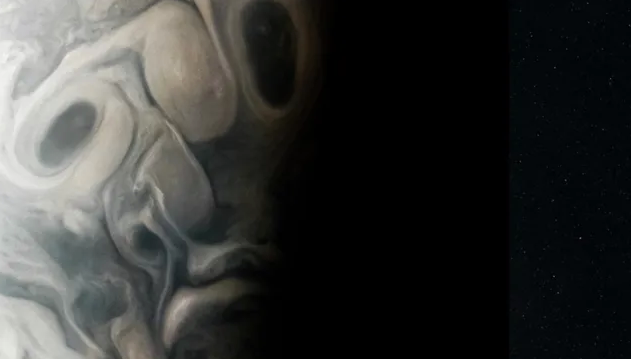Jupiter has a creepy ‘face’ in haunting Halloween photo by NASA
The photo shows swirling clouds and turbulent storms on Jupiter, which resemble an eerie, elongated frowning face

A NASA spacecraft captured a ghoulish “face” on Jupiter on a recent flyby, just in time for Halloween.
The Juno spacecraft captured the image from an altitude of about 4,800 miles and a latitude around 69 degrees north.
The photo shows swirling clouds and turbulent storms on Jupiter, which resemble an eerie, elongated frowning face.
The region of the planet photographed lies along Jupiter’s terminator — the dividing line between the day and night sides of the planet — which is why the planet appears to disappear into darkness.
Nasa released the photo on 25 October, just before Halloween and compared the haunting view to a painting by Picasso.
“We present the @NASASolarSystem image to you on Oct. 25 — what would have been Picasso’s 142nd birthday,” NASA said in a post on X.
“The swirling clouds of Jupiter appear to form a frowning human face. Half of the image is in darkness on the planet’s night side, almost making the face appear as if it’s peering out from behind a door,” NASA added.
“The low angle of sunlight highlights the complex topography of features in this region, which scientists have studied to better understand the processes playing out in Jupiter’s atmosphere.”
Swirling clouds are commonly seen on Jupiter due to the planet’s turbulent weather system.
Powerful storms in the planet’s atmosphere fuel fierce jet stream winds that create cyclones and anticyclones which circulate in opposite directions. This is what created the appearance of a face on the planet, NASA scientists explained.
“As often occurs in views from Juno, Jupiter’s clouds in this picture lend themselves to pareidolia, the effect that causes observers to perceive faces or other patterns in largely random patterns,” NASA officials said.
In January, NASA astronomers discovered a strange structure on Mars resembling a bear’s face, marking yet another instance of pareidolia.
Meanwhile, in May last year, NASA’s Curiosity Mars rover spotted a strange rock formation that looked like an “alien doorway” on the Red Planet.
Scientists said the rock feature may have formed as a result of natural stress fractures likely caused by seismic activities.
Another rock formation spotted in February last year resembled a tranquil person hanging out on Mars.
Join our commenting forum
Join thought-provoking conversations, follow other Independent readers and see their replies
Comments
Bookmark popover
Removed from bookmarks